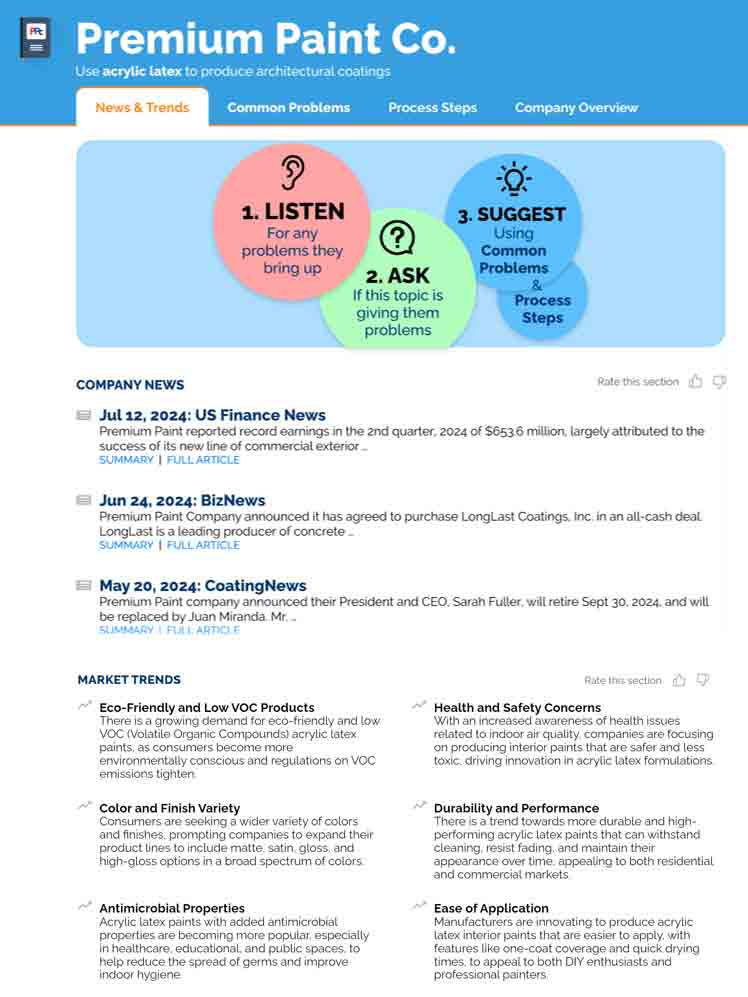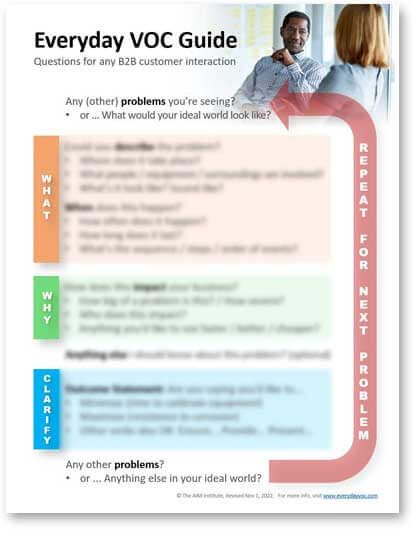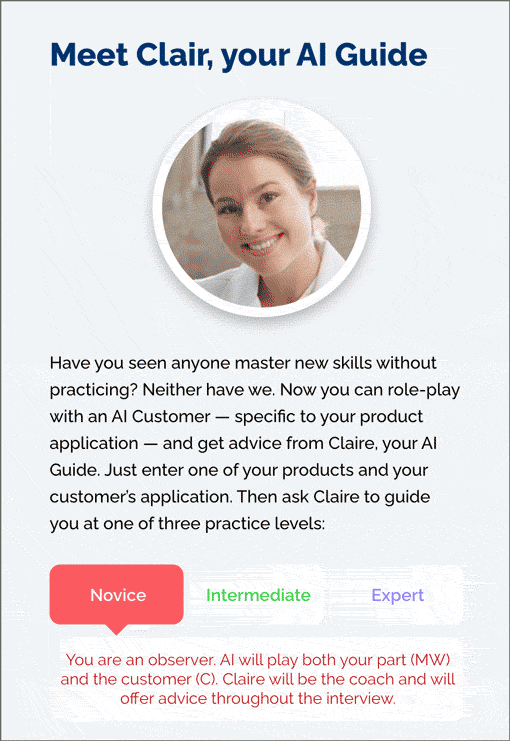Sales call preparation: Do it faster & better with AI

The research on B2B sales call preparation isn’t encouraging: 75% of B2B executive buyers say salespeople are not knowledgeable about their business and do not understand the issues they face.1 Unsurprisingly, only one in four salespeople get agreement from these buyers to meet again.2 Let’s see how the clever use of AI can change this.
When we say, “sales call preparation,” we mean preparing with both insights and skills:
- Insights: When a sales professional has gathered high-quality, pre-call information about the customer and their issues, they are welcomed into a deep conversation about how they might help the customer.
- Skills: When a salesperson has mastered probing skills to ask the right questions, they sell more. Why? Because they learn which customer pain points to address and demonstrate they are interested in the customer.

 Turns out you need both types of sales call preparation. Pre-call insights alone don’t go “deep” enough: This information won’t tell you what your customer is wrestling with today. You’ll need to skillfully ask questions for that.
Turns out you need both types of sales call preparation. Pre-call insights alone don’t go “deep” enough: This information won’t tell you what your customer is wrestling with today. You’ll need to skillfully ask questions for that.
And if you show up ignorant and unprepared—even with great probing skills—it’s unlikely your customer contact will have much time for you. Let’s see how AI can support both forms of sales call preparation, beginning with insights.
Download our white paper at www.SalesCallPreparation.com
Sales call preparation for INSIGHTS
Imagine you’re a salesperson preparing to call on an existing B2B customer. What will you spend most of your time talking about… your product or their world? Customers don’t care about your product: They simply “hire” your product to accomplish their “job to be done” (aka, their application or task).
In a study of nearly 24,000 sales conversations—all of which were consultative in nature—the top performers talked about their product features only half as much as other salespeople.3
Top performers talked about their product features only half as much as other salespeople.
Of course, you want to be a top performer, but what “customer world” information should you gather ahead of your meeting? Your sales call preparation should include five items:
- Business status: You’ll need a refresher on all aspects of your current business dealings with this customer, e.g. orders, pricing, commitments made during your last call, etc. When you have this information at your fingertips, you establish yourself as a credible professional.
- Company news: You don’t want to be surprised by their new acquisition, divestiture, vice-president, or company announcement. And this background can give you great “icebreakers” to start your meeting: “Are you personally impacted by your company’s new acquisition?”
- Market trends: You’ll be able to engage your customer more deeply if you’re conversant in the trends their specific industry is facing: “I’ve been reading about this trend, and I wanted to get your opinion on it.”
- Common problems: When you gather the top 15-20 problems faced by companies in your customer’s type of business, it helps in two ways: 1) If your customer brings up one of these problems, you’ll be prepared to discuss it, and 2) you can ask them if they are dealing with some of these issues.
- Process steps: The final item for sales call preparation is becoming familiar with the steps your customer goes through when using your type of offering. This lets you explore steps you could help them to accomplish faster, better, or cheaper.
If the company you call on is unfamiliar to you, then supplement the above list with information on a) the specific person you’re meeting with (perhaps using a LinkedIn search), and b) an overview of this company, such as their products, organization, leadership, competitors, and any published strategy.

For the first of the five items listed above for sales call preparation (business status), you’ll need to rely on your existing CRM (customer relationship management) system. But the remaining four items can be delivered to you in less than 60 seconds today using AI. One such AI approach is the SalesPrepTM system, at www.salesprep.com. You just enter three items:
- The company you’ll call on (e.g. Caterpillar)
- Your type of offering (e.g. hydraulic cylinders)
- The customer’s job-to-be-done (e.g. manufacturing backhoes)
This provides you with high-quality insights and can easily save you 30 minutes of sales call preparation per day. At $50/hour, that’s a time savings of $500/month. To download a sample report, visit www.SalesPrepReport.com.
The SalesPrep report can be viewed on your phone as well as desktop computer. It includes “prompts” for questions you can ask, which can be helpful to review…
- in the customer’s lobby before the meeting starts,
- during a virtual Zoom or Teams meeting, or
- during the meeting using brief glances at your phone.
Being prepared ahead of your call with these insights is half the battle. The second half—gaining the skills to ask the right questions—is covered in the next section.

Sales call preparation for SKILLS
Sales professionals who ask the right questions sell more. Sales call preparation is critical. The evidence is compelling:
- In the research behind the landmark book, Spin Selling, 35,000 sales calls were monitored. They found the most successful sellers asked questions about the customer’s Situation, Problems, Implications, and Needs/Payoff.4
- Sales Insights Labs analyzed 23,900 sales conversations and learned that top performers asked 39% more questions than the average salesperson.5
- At The AIM Institute, we surveyed nearly 400 B2B salespeople on 12 voice-of-customer skills, and found a strong correlation between probing skills and selling success. To download this report, visit VOCforSales.com.
But what are these “right” questions? For two decades, we’ve been training professionals in B2B-optimized probing methods to uncover and understand their customers’ needs. Our approach is called the “What-Why-Clarify” method.
- You begin by asking “What” questions, such as “Can you describe this?”… “How often does this happen?”… or “When do you see this problem?”
- Then you ask “Why” questions. One of the best is, “How does this impact you?”
- Then you “Clarify” by venturing a summary “outcome statement” such as, “Are you saying you want to minimize the paint’s drying time?”
You can download these tips in the “Everyday VOC Guide” at www.salesprep.com.
But how could AI possibly help you master this probing method for sales call preparation? Here’s where it gets interesting: The only way to master a new skill is with practice, practice, practice. Until now this required “synchronous” coaching. By this, we mean a human coach advises learners on a real-time basis during a workshop. As you can imagine, this can be inconvenient and costly.
But now there’s an AI Guide—we call her “Claire”—who provides this coaching “asynchronously” …
- any time you want to practice on your own.
- on any offering and customer job-to-be-done you’d like to practice on.
- with the same—or possibly higher—level of advice you’d get with a human.
You can enter any offering and any application (job to be done) that customers might use your offering to accomplish:
To check this out, visit www.salesprep.com, and scroll down until you see Meet Claire, your AI Guide, and click the orange button.
Getting started on sales call preparation…
As you’ve seen, the use of AI can boost both the effectiveness and efficiency of your sales call preparation. When you have great pre-call insights and ask excellent questions about their world, you’ll sell more. Here’s why:
- Now you know which of your products to recommend.
- The customer just told you how to sell (which pain points to address).
- Customers love to work with people interested in them.
To get started, visit www.salesprep.com or contact us at www.talkwithAIM.com.
1 Mark Lindwall, Why Don’t Buyers Want To Meet With Your Salespeople?, Forrester Research, 2014.
2 Ibid
3 Sales Insights Labs, https://salesinsightslab.com/sales-research/
4 Neil Rackham, SPIN Selling, (New York: McGraw Hill, 1988).
5 Ibid, Sales Insights Labs




Comments